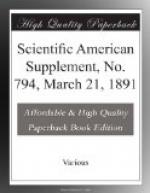^
=
=
=
=
a
=
=
\ =
/
|
= |
|~~~~~~~~~~~~~~|
| - -
= - -|
|- -
= - |
| - -
= - -|
|- -
= - |
| - /
\ -|
|- - |
b | - |
| \
/ -|
|- e//-
-\\d |
| - | c
| -|
|- \
_ / |
| - \
/ -|
|-
= - |
| -
= -|
|- |
| - |
| - \f/
-|
|- -
v - |
|
-|
/
\
------------------
The glass bulb, c, when filled with the test fluid, is closed by means of an accurately fitting glass stopper, d, and the instrument is then placed in a glass cylinder filled with distilled water of 17.5 deg. temperature (Centigrade). The gravity is then at once shown on the divided scale in the tube, a. The lower bulb, f, contains some mercury; e is a small glass knob, which serves to maintain the balance, while b is an empty glass bulb (floater).
These instruments are admirably adapted for determining the gravity of alcohol, petroleum, benzine, and every kind of oil, also for testing beer, milk, vinegar, grape juice, lye, glycerine, urine, etc.
As the process is an exceedingly simple one and free from the drawbacks of the araeometer, we are justified in concluding that the araeo-picnometer will soon be in general use.
H. HENSOLDT, Ph.D.
Petrographical Laboratory, School of Mines, Columbia College.
* * * * *
[Continued from SUPPLEMENT, No. 793, page 12669.]
GASEOUS ILLUMINANTS.[1]
[Footnote: Lectures recently delivered before the Society of Arts, London. From the Journal of the Society.]
BY PROF. VIVIAN B LEWES.
IV.
Mr. Frank Livesey, in the concluding sentence of a paper read before the Southern District Association of Gas Managers and Engineers during the past month, on “A Ready Means of Enriching Coal Gas,” speaking of enrichment by gasolene by the Maxim-Clarke process, said “it should, in many cases, take the place of cannel, to be replaced in its turn, probably, by a water gas carbureted to 20 or 25 candle power.” And now, having fully reviewed the methods either in use or proposed for the enrichment of gas, we will pass on to this, the probable cannel of the future.
Discovered by Fontana, in 1780, and first worked by Ibbetson, in England, in 1824, water gas has added a voluminous chapter to the patent records of England, France, and America, no less than sixty patents being taken out between 1824 and 1858, in which the action of steam on incandescent carbon was the basis for the production of an inflammable gas.




